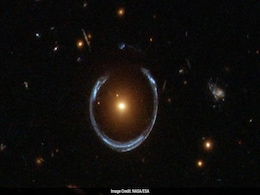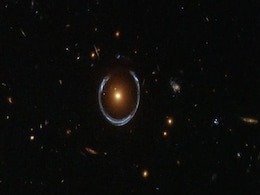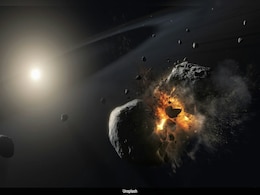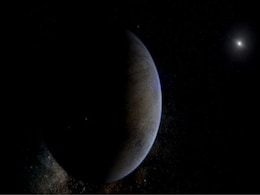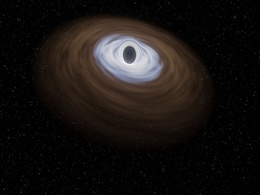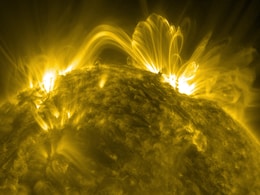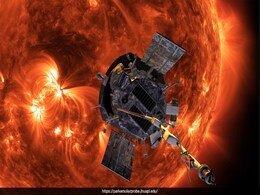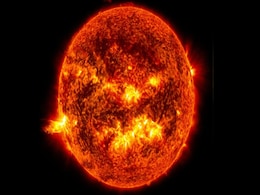Size Of Sun
- All
- News
- Videos
-

UY Scuti Reigns as the Universe’s Biggest Known Star, but Its Crown May Be at Risk
- Monday September 8, 2025
- Written by Gadgets 360 Staff
UY Scuti, a red hypergiant about 1,700 times the Sun’s radius, is the universe’s largest known star. Nearly 5 billion suns could fit inside its volume, but rivals like NML Cygni and Westerlund 1-26 challenge its claim to the crown. Astronomers stress that size estimates carry large uncertainties, leaving the title of biggest star still conteste...
-
 www.gadgets360.com
www.gadgets360.com
-

Habitable Zone Explained: The ‘Goldilocks Zone’ Where Life-Friendly Planets May Exist
- Tuesday August 12, 2025
- Written by Gadgets 360 Staff
The habitable zone, or “Goldilocks zone”, is the region around a star where conditions allow liquid water to exist. Varying with star type, this zone is key in the search for life. Earth’s location in the Sun’s habitable zone has made life possible, and astronomers seek similar rocky exoplanets in other systems to explore the possibility of...
-
 www.gadgets360.com
www.gadgets360.com
-

Biggest-Ever Black Hole With Mass Of 36 Billion Suns Discovered: 'Cosmic Behemoth'
- Saturday August 9, 2025
- Offbeat | Edited by Abhinav Singh
The gigantic black hole's size is close to the theoretical upper limit of what is possible in the universe.
-
 www.ndtv.com
www.ndtv.com
-

Astronomers Detect Black Hole 36 Billion Times the Sun’s Mass, Among Largest Ever Found
- Wednesday August 13, 2025
- Written by Gadgets 360 Staff
Astronomers have detected a dormant black hole with a mass equal to 36 billion Suns in the Cosmic Horseshoe system, 5 billion light-years away. Identified via gravitational lensing and stellar motion, it ranks among the largest known black holes. The discovery sheds light on the link between galaxy size and central black hole growth.
-
 www.gadgets360.com
www.gadgets360.com
-

'City-Killer' Asteroid May Hit Moon, Hurl Deadly Debris Toward Earth
- Friday June 20, 2025
- Science | Edited by Nikhil Pandey
Asteroid 2024 YR4 might collide with the Moon in 2031, with a 4.3% chance of impact, according to NASA's updated calculations.
-
 www.ndtv.com
www.ndtv.com
-

New Dwarf Planet Discovery Challenges Planet Nine Hypothesis
- Monday June 2, 2025
- Written by Gadgets 360 Staff
The discovery of a potential dwarf planet, 2017 OF201, in the farthest reaches of the solar system is reshaping our understanding of space. With a highly elongated orbit and large size, it contradicts the Planet Nine hypothesis, which predicted orbital clustering among distant objects. This finding not only questions the existence of a ninth planet...
-
 www.gadgets360.com
www.gadgets360.com
-

NASA Hubble Space Telescope Helps Confirm the First Solitary Black Hole
- Friday April 18, 2025
- Written by Gadgets 360 Staff
In the Sagittarius constellation, a lone and first-ever solitary black hole has been discovered by a team of scientists. Although the discovery began in the year 2011, the observations have confirmed it recently. The size of this black hole is as massive as seven times of the sun. Despite the conflicts and differences of observations by another tea...
-
 www.gadgets360.com
www.gadgets360.com
-

James Webb Space Telescope Detects Supernova From 11.4 Billion Years Ago
- Friday January 17, 2025
- Written by Gadgets 360 Staff
Astronomers using the James Webb Space Telescope (JWST) have identified AT 2023adsv, a supernova that occurred 11.4 billion years ago. This stellar explosion, from a star 20 times the size of the Sun, offers a glimpse into the early universe's unique stellar evolution. Part of the JWST Advanced Deep Extragalactic Survey, the event highlights how th...
-
 www.gadgets360.com
www.gadgets360.com
-

Scientists Predict Ultramassive Black Holes Can’t Grow Beyond 100 Billion Suns
- Monday December 9, 2024
- Written by Gadgets 360 Staff
Scientists led by Dr Priyamvada Natarajan from Yale University have discovered that ultramassive black holes likely cannot exceed 100 billion solar masses. These giants regulate their own growth by emitting gas jets that heat and expel surrounding material, cutting off their gas supply. Additionally, the team is exploring intermediate-mass black ho...
-
 www.gadgets360.com
www.gadgets360.com
-

First Zoomed-in Picture of a Star Outside Our Galaxy Captured, Revealed to Be a Dying Star
- Monday November 25, 2024
- Written by Gadgets 360 Staff
The first detailed image of a star outside the Milky Way reveals WOH G64, a giant nearing its end. Captured by the Very Large Telescope Interferometer, this dying star, 1,500 times the size of the Sun, is surrounded by a cocoon of gas and dust, hinting at its eventual collapse into a supernova.
-
 www.gadgets360.com
www.gadgets360.com
-

NASA's Parker Solar Probe To Have Final Venus Flyby Today Ahead Of Historic Sun Encounter
- Wednesday November 6, 2024
- World News | Edited by NDTV News Desk
The Parker Solar Probe was launched in 2018 on the mission to "touch" the Sun. It is just about the size of a small car.
-
 www.ndtv.com
www.ndtv.com
-

New Group of Distant Objects Suggests Our Solar System May Have a Second Kuiper Belt
- Saturday September 21, 2024
- Written by Gadgets 360 Staff
Astronomers have discovered 11 objects beyond the Kuiper Belt, suggesting the existence of a second belt, dubbed "Kuiper Belt 2." Located between 70 and 90 AU from the sun, this new region could redefine our understanding of the solar system's size and structure. The discovery was made using the Subaru telescope in collaboration with NASA’s New H...
-
 www.gadgets360.com
www.gadgets360.com
-

NASA Might Have Spotted Highest Number of Sunspots in Over 20 Years
- Tuesday August 20, 2024
- Gadgets 360 Staff
On August 8, 2024, NASA's Solar Dynamics Observatory (SDO) may have documented a record-breaking number of sunspots in a single day, marking a significant event in Solar Cycle 25. These sunspots, which are dark, cooler areas on the Sun’s surface caused by intense magnetic activity, play a crucial role in the Sun's behaviour and have a direct impa...
-
 www.gadgets360.com
www.gadgets360.com
-

2 Scientists Claim That The Sun Is Fractionally Smaller Than We Thought
- Thursday November 9, 2023
- Science | Edited by Ritu Singh
Two astronomers have found evidence that the radius of our Sun is a few hundredths of a percent slimmer than previous analyses indicated.
-
 www.ndtv.com
www.ndtv.com
-

UY Scuti Reigns as the Universe’s Biggest Known Star, but Its Crown May Be at Risk
- Monday September 8, 2025
- Written by Gadgets 360 Staff
UY Scuti, a red hypergiant about 1,700 times the Sun’s radius, is the universe’s largest known star. Nearly 5 billion suns could fit inside its volume, but rivals like NML Cygni and Westerlund 1-26 challenge its claim to the crown. Astronomers stress that size estimates carry large uncertainties, leaving the title of biggest star still conteste...
-
 www.gadgets360.com
www.gadgets360.com
-

Habitable Zone Explained: The ‘Goldilocks Zone’ Where Life-Friendly Planets May Exist
- Tuesday August 12, 2025
- Written by Gadgets 360 Staff
The habitable zone, or “Goldilocks zone”, is the region around a star where conditions allow liquid water to exist. Varying with star type, this zone is key in the search for life. Earth’s location in the Sun’s habitable zone has made life possible, and astronomers seek similar rocky exoplanets in other systems to explore the possibility of...
-
 www.gadgets360.com
www.gadgets360.com
-

Biggest-Ever Black Hole With Mass Of 36 Billion Suns Discovered: 'Cosmic Behemoth'
- Saturday August 9, 2025
- Offbeat | Edited by Abhinav Singh
The gigantic black hole's size is close to the theoretical upper limit of what is possible in the universe.
-
 www.ndtv.com
www.ndtv.com
-

Astronomers Detect Black Hole 36 Billion Times the Sun’s Mass, Among Largest Ever Found
- Wednesday August 13, 2025
- Written by Gadgets 360 Staff
Astronomers have detected a dormant black hole with a mass equal to 36 billion Suns in the Cosmic Horseshoe system, 5 billion light-years away. Identified via gravitational lensing and stellar motion, it ranks among the largest known black holes. The discovery sheds light on the link between galaxy size and central black hole growth.
-
 www.gadgets360.com
www.gadgets360.com
-

'City-Killer' Asteroid May Hit Moon, Hurl Deadly Debris Toward Earth
- Friday June 20, 2025
- Science | Edited by Nikhil Pandey
Asteroid 2024 YR4 might collide with the Moon in 2031, with a 4.3% chance of impact, according to NASA's updated calculations.
-
 www.ndtv.com
www.ndtv.com
-

New Dwarf Planet Discovery Challenges Planet Nine Hypothesis
- Monday June 2, 2025
- Written by Gadgets 360 Staff
The discovery of a potential dwarf planet, 2017 OF201, in the farthest reaches of the solar system is reshaping our understanding of space. With a highly elongated orbit and large size, it contradicts the Planet Nine hypothesis, which predicted orbital clustering among distant objects. This finding not only questions the existence of a ninth planet...
-
 www.gadgets360.com
www.gadgets360.com
-

NASA Hubble Space Telescope Helps Confirm the First Solitary Black Hole
- Friday April 18, 2025
- Written by Gadgets 360 Staff
In the Sagittarius constellation, a lone and first-ever solitary black hole has been discovered by a team of scientists. Although the discovery began in the year 2011, the observations have confirmed it recently. The size of this black hole is as massive as seven times of the sun. Despite the conflicts and differences of observations by another tea...
-
 www.gadgets360.com
www.gadgets360.com
-

James Webb Space Telescope Detects Supernova From 11.4 Billion Years Ago
- Friday January 17, 2025
- Written by Gadgets 360 Staff
Astronomers using the James Webb Space Telescope (JWST) have identified AT 2023adsv, a supernova that occurred 11.4 billion years ago. This stellar explosion, from a star 20 times the size of the Sun, offers a glimpse into the early universe's unique stellar evolution. Part of the JWST Advanced Deep Extragalactic Survey, the event highlights how th...
-
 www.gadgets360.com
www.gadgets360.com
-

Scientists Predict Ultramassive Black Holes Can’t Grow Beyond 100 Billion Suns
- Monday December 9, 2024
- Written by Gadgets 360 Staff
Scientists led by Dr Priyamvada Natarajan from Yale University have discovered that ultramassive black holes likely cannot exceed 100 billion solar masses. These giants regulate their own growth by emitting gas jets that heat and expel surrounding material, cutting off their gas supply. Additionally, the team is exploring intermediate-mass black ho...
-
 www.gadgets360.com
www.gadgets360.com
-

First Zoomed-in Picture of a Star Outside Our Galaxy Captured, Revealed to Be a Dying Star
- Monday November 25, 2024
- Written by Gadgets 360 Staff
The first detailed image of a star outside the Milky Way reveals WOH G64, a giant nearing its end. Captured by the Very Large Telescope Interferometer, this dying star, 1,500 times the size of the Sun, is surrounded by a cocoon of gas and dust, hinting at its eventual collapse into a supernova.
-
 www.gadgets360.com
www.gadgets360.com
-

NASA's Parker Solar Probe To Have Final Venus Flyby Today Ahead Of Historic Sun Encounter
- Wednesday November 6, 2024
- World News | Edited by NDTV News Desk
The Parker Solar Probe was launched in 2018 on the mission to "touch" the Sun. It is just about the size of a small car.
-
 www.ndtv.com
www.ndtv.com
-

New Group of Distant Objects Suggests Our Solar System May Have a Second Kuiper Belt
- Saturday September 21, 2024
- Written by Gadgets 360 Staff
Astronomers have discovered 11 objects beyond the Kuiper Belt, suggesting the existence of a second belt, dubbed "Kuiper Belt 2." Located between 70 and 90 AU from the sun, this new region could redefine our understanding of the solar system's size and structure. The discovery was made using the Subaru telescope in collaboration with NASA’s New H...
-
 www.gadgets360.com
www.gadgets360.com
-

NASA Might Have Spotted Highest Number of Sunspots in Over 20 Years
- Tuesday August 20, 2024
- Gadgets 360 Staff
On August 8, 2024, NASA's Solar Dynamics Observatory (SDO) may have documented a record-breaking number of sunspots in a single day, marking a significant event in Solar Cycle 25. These sunspots, which are dark, cooler areas on the Sun’s surface caused by intense magnetic activity, play a crucial role in the Sun's behaviour and have a direct impa...
-
 www.gadgets360.com
www.gadgets360.com
-

2 Scientists Claim That The Sun Is Fractionally Smaller Than We Thought
- Thursday November 9, 2023
- Science | Edited by Ritu Singh
Two astronomers have found evidence that the radius of our Sun is a few hundredths of a percent slimmer than previous analyses indicated.
-
 www.ndtv.com
www.ndtv.com




